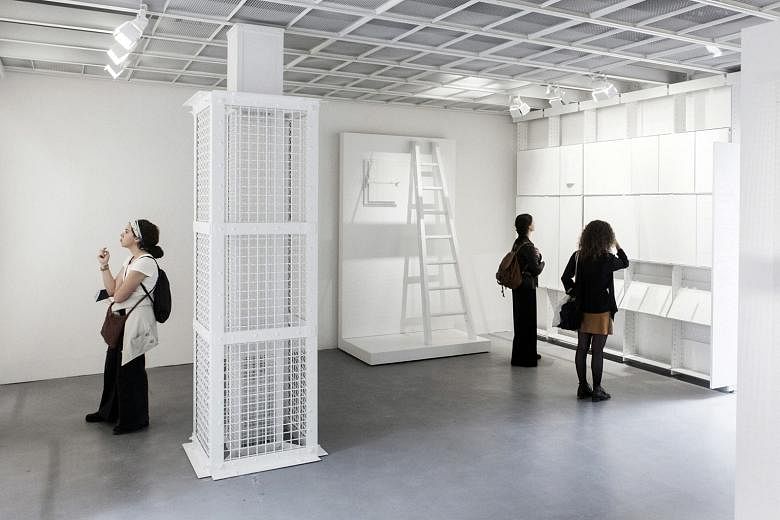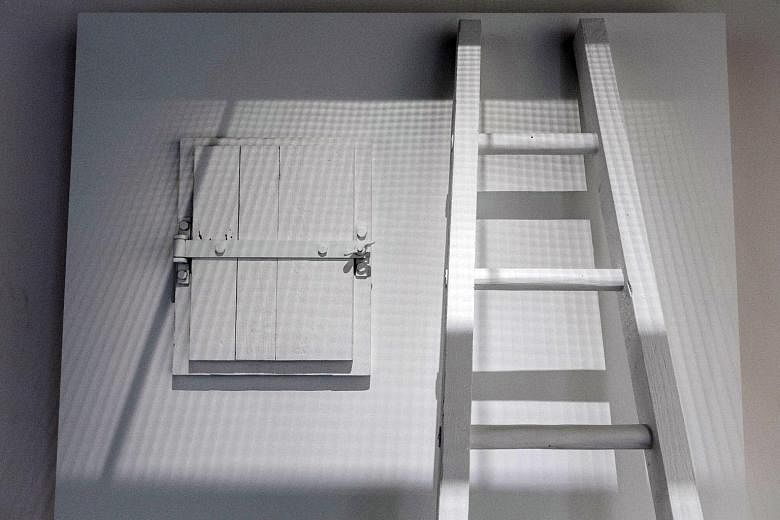VENICE • On a recent afternoon, historian Robert Jan van Pelt was standing in a quiet room at the 15th Venice Architecture Biennale, explaining the significance of an unassuming steel-mesh column that visitors to this sprawling survey of global design might walk right past.
"This is one of the most deadly things so far created," van Pelt said.
And it was the handiwork, he noted, of an architect.
The column - painted, like everything else in the room, a pristine white - is a reproduction of one of the eight chutes used to lower Zyklon B poison pellets into gas chambers at Auschwitz.
It was built on the basis of historical documents introduced in the 2000 libel case brought by the British historian and Holocaust denier David Irving, at which van Pelt, a leading authority on the construction of that Nazi death camp, was an expert witness.
Now, it is also the centrepiece of The Evidence Room, a haunting installation that stands as a reminder of architecture's potential both to do unspeakable harm and to argue for truth against lies.
Alejandro Aravena, artistic director of the biennale, calls van Pelt's expert testimony a powerful example of "reversed architectural logic". Van Pelt "has studied the camps as if he had the problem of designing them and used that knowledge in the trial to triumph over negationism", Aravena said in a telephone interview.
The room, based on van Pelt's nearly 600-page book, The Case For Auschwitz: Evidence From the Irving Trial (2002), is one of the more unusual installations in a biennale dedicated to the ethical dimension of architecture, and one of the few featuring the work of a non-designer.
Entering the room, which uses four shades of white, feels like walking into a combination of an architectural model and a fossil- specimen hall.
The walls are lined with plaster reliefs based on photographs, drawings, blueprints and other documents introduced during the trial to counter Irving's claim that there were no gas chambers at Auschwitz.
One photograph shows a group portrait of the Auschwitz Central Construction Management team, including the head of the design department, Walter Dejaco.
An inscription near the entrance describes the death camps as "the greatest crime committed by architects", but there is minimal explanatory text in the room itself.
The Nazis, who evacuated Auschwitz in early 1945 as Soviet forces approached, did their best to hide those evidentiary crumbs. Before leaving, they blew up the gas chambers and crematories. No surviving documents from the camp label the gas chambers as such.
But the material gathered by van Pelt, and cast in plaster in the room, speaks to a deadly purpose.
There are letters and memos requesting the construction of gas- tight doors and shutters. An aerial photograph taken by Allied planes in August 1944 shows four dots on the roof of Crematorium 3 at Auschwitz - hatches for the gas columns, van Pelt said - in a zig-zag pattern that matches an eyewitness account of the location of the columns.
The most striking elements of the room, which will remain on view here until Nov 27, are three full-size reproductions, or "monuments" as the team calls them: the gas column, a fragment of wall from a crematory and a gas chamber door. They are unlabelled, but their details, once explained, are almost unbearably chilling.
The door, known from a photograph taken by a Soviet soldier and other documents, has on one side a bolt, a handle and a peephole. On the other side, there is only the peephole, covered by a protective mesh cage - the sort of thing, van Pelt noted, that you normally see only on the outside of a door.
A document reproduced in the exhibition indicates that the peephole was added when rooms, designed as morgues, were retrofitted as gas chambers, at which point the hinges were adjusted so the doors opened out, rather than in, van Pelt said. When they were opened, as many as 2,000 corpses would be piled against the walls and door, with strongest adults on top, children on the bottom.
"Many people died because there was a stampede," van Pelt said.
The Evidence Room, by contrast, has an almost ethereal calm that, for some, may come uncomfortably close to beauty and perhaps to violating Shoah director Claude Lanzmann's injunction against directly representing the Holocaust.
"I always had that in the back of my mind," said van Pelt, who has been critical of preservation efforts that turn death camps into "a kind of theme park", as he once put it.
The column also raises tricky questions of authenticity. The eight used at Auschwitz, van Pelt said, were dismantled by the Nazis in late 1944 and vanished. Their general appearance is known from accounts by some of the perhaps 100 people, by his estimate, who saw them and lived, including prisoners tasked with clearing corpses.
"We know how this thing could have been built, but we don't know for sure how it was built," said Donald McKay, an architect and fellow professor at the architecture school of the University of Waterloo in Ontario and who was part of the research team for van Pelt's book.
McKay, who made the construction drawings for the reproduction of the column, added: "It's still a ghost."
NEW YORK TIMES


